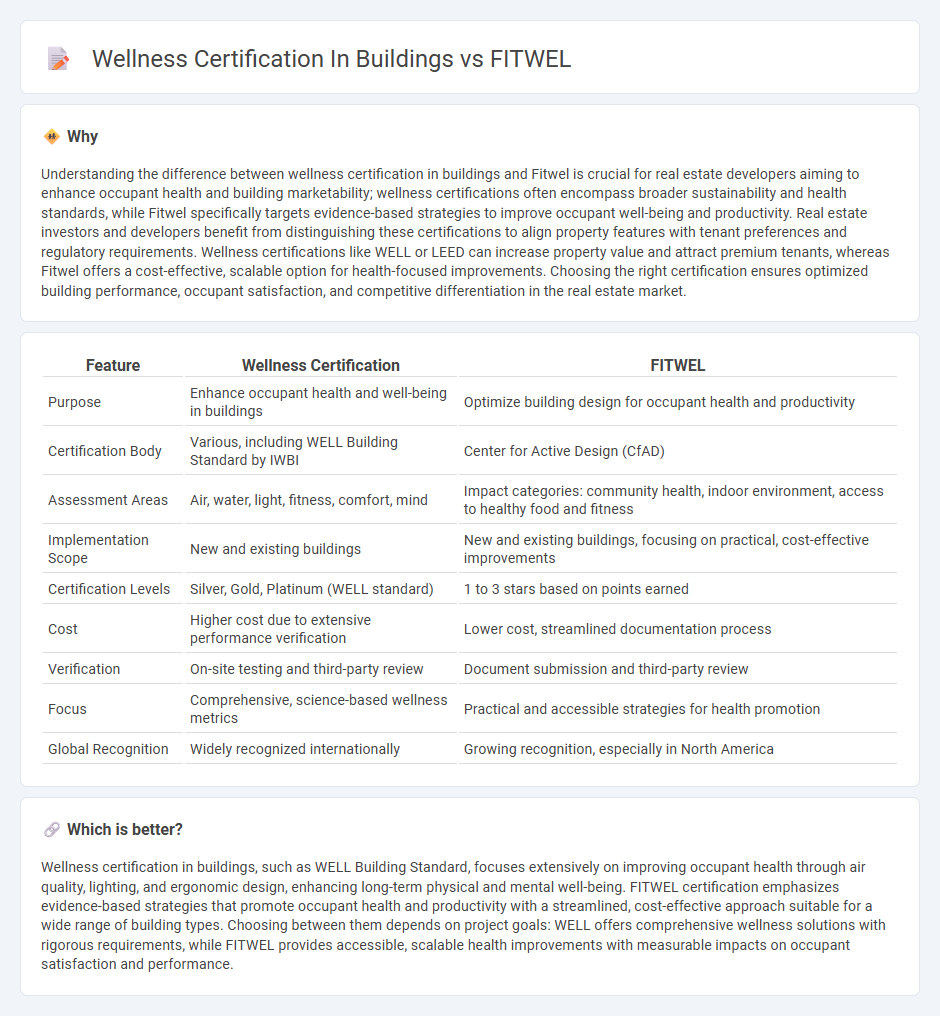
Wellness certification in buildings, such as WELL Building Standard, focuses on promoting occupant health and well-being through design, materials, and operational strategies, emphasizing air quality, lighting, and fitness. FITWEL, developed by the U.S. Centers for Disease Control and Prevention and the General Services Administration, offers a simpler, cost-effective certification targeting improvements in occupant health, productivity, and sustainability with actionable strategies. Explore the key differences and benefits between these certifications to enhance your real estate project's wellness impact.
Why it is important
Understanding the difference between wellness certification in buildings and Fitwel is crucial for real estate developers aiming to enhance occupant health and building marketability; wellness certifications often encompass broader sustainability and health standards, while Fitwel specifically targets evidence-based strategies to improve occupant well-being and productivity. Real estate investors and developers benefit from distinguishing these certifications to align property features with tenant preferences and regulatory requirements. Wellness certifications like WELL or LEED can increase property value and attract premium tenants, whereas Fitwel offers a cost-effective, scalable option for health-focused improvements. Choosing the right certification ensures optimized building performance, occupant satisfaction, and competitive differentiation in the real estate market.
Comparison Table
| Feature | Wellness Certification | FITWEL |
|---|---|---|
| Purpose | Enhance occupant health and well-being in buildings | Optimize building design for occupant health and productivity |
| Certification Body | Various, including WELL Building Standard by IWBI | Center for Active Design (CfAD) |
| Assessment Areas | Air, water, light, fitness, comfort, mind | Impact categories: community health, indoor environment, access to healthy food and fitness |
| Implementation Scope | New and existing buildings | New and existing buildings, focusing on practical, cost-effective improvements |
| Certification Levels | Silver, Gold, Platinum (WELL standard) | 1 to 3 stars based on points earned |
| Cost | Higher cost due to extensive performance verification | Lower cost, streamlined documentation process |
| Verification | On-site testing and third-party review | Document submission and third-party review |
| Focus | Comprehensive, science-based wellness metrics | Practical and accessible strategies for health promotion |
| Global Recognition | Widely recognized internationally | Growing recognition, especially in North America |
Which is better?
Wellness certification in buildings, such as WELL Building Standard, focuses extensively on improving occupant health through air quality, lighting, and ergonomic design, enhancing long-term physical and mental well-being. FITWEL certification emphasizes evidence-based strategies that promote occupant health and productivity with a streamlined, cost-effective approach suitable for a wide range of building types. Choosing between them depends on project goals: WELL offers comprehensive wellness solutions with rigorous requirements, while FITWEL provides accessible, scalable health improvements with measurable impacts on occupant satisfaction and performance.
Connection
Wellness certification in buildings, such as WELL Building Standard, integrates health-focused design strategies that improve occupant well-being, while FITWEL complements this by providing a streamlined, evidence-based certification framework targeting operational practices and health-promoting environments. Both certifications emphasize enhancing indoor air quality, promoting physical activity, and optimizing thermal comfort to create healthier real estate assets. Implementing wellness certification alongside FITWEL can significantly increase property value and attract health-conscious tenants and investors.
Key Terms
Health Impact
FITWEL certification prioritizes occupant health by optimizing building design for reduced disease transmission and enhanced mental well-being. Wellness certification programs, such as WELL, focus broadly on holistic health aspects including air quality, nutrition, and fitness amenities. Discover how these certifications impact building health performance and occupant wellness by exploring detailed comparisons.
Certification Criteria
FITWEL certification emphasizes occupant health and well-being through criteria such as community connectivity, indoor air quality, and access to healthy food options. Wellness certifications generally focus on broader aspects including physical activity support, mental health promotion, and ergonomics within building design. Explore detailed comparison to understand which certification aligns best with your building's goals.
Operational Policies
FITWEL certification emphasizes evidence-based operational policies that enhance occupant health by promoting clean air standards, active design, and social equity within buildings. Wellness certification programs, such as WELL Building Standard, prioritize operational policies targeting indoor air quality, lighting, and thermal comfort to optimize occupant wellbeing. Explore detailed comparisons to understand how each certification shapes healthier building operations.
Source and External Links
fitwel-building-certification-system - Fitwel is a building certification system focused on human health, developed in partnership with the US CDC and GSA, emphasizing practical, scalable health strategies.
fitwel-vs-well - Fitwel and WELL are compared in terms of their certification approaches, with Fitwel being more practical and faster, while WELL is more holistic and rigorous.
fitwel - Fitwel is a pioneering real estate platform that translates public health research into a global certification standard, impacting over 2.6 million people and 1.2 billion square feet of properties worldwide.
 dowidth.com
dowidth.com